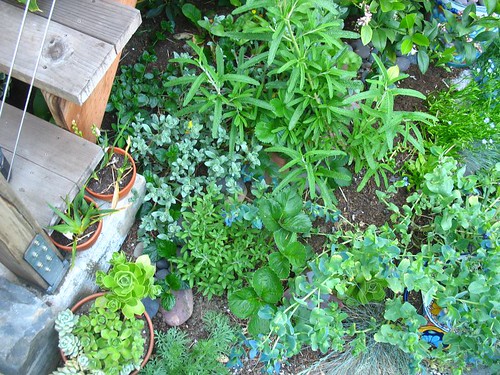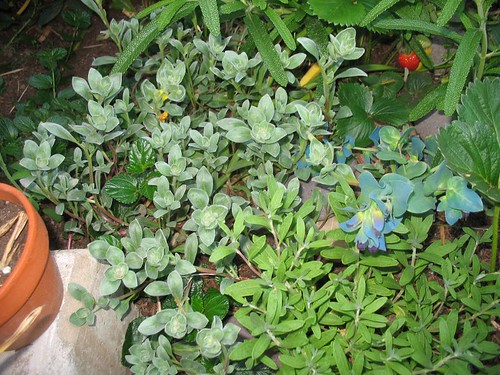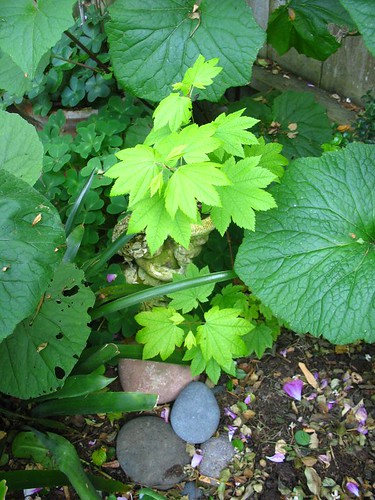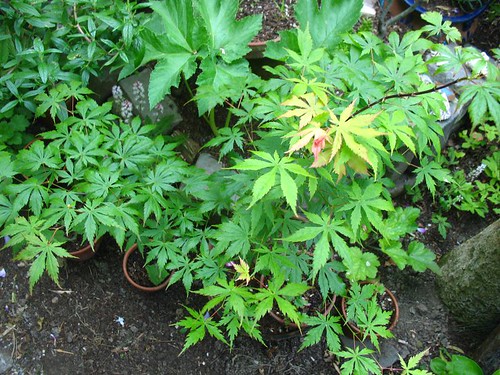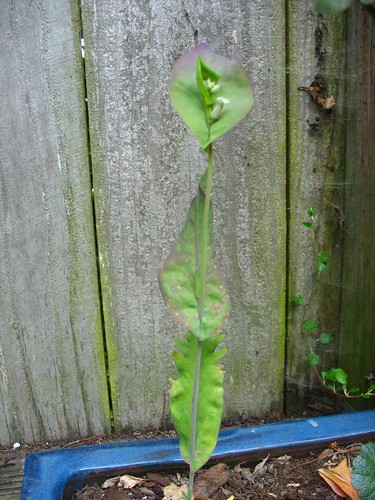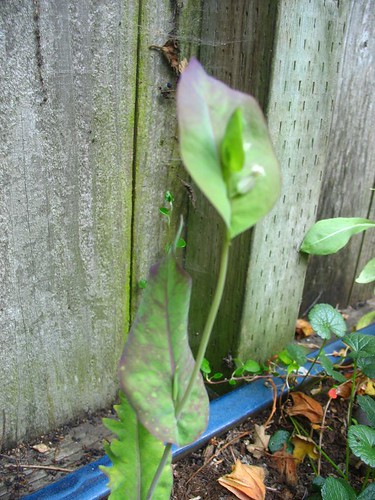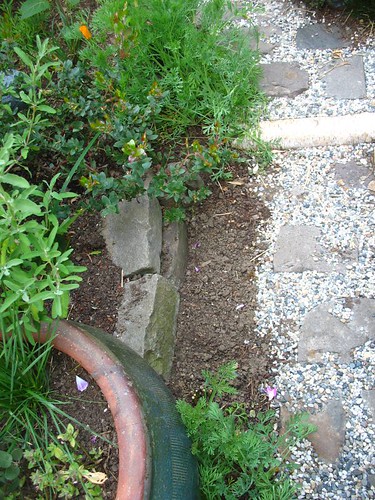We had to write a short research paper on some topic of soil relevance for my soil science class. I decided to write about phosphorus.
Since I only took the class for personal interest, I don't have to worry about the usual formalities of paper-writing. Instead of organizing around a central concept, I researched and wrote up several disparate points of phosphorus interest (interesting
to me).
I'm posting my final paper because the blog is something I also do primarily for me, and if I ever want to find these stray bits of information again, I'll know right where to go. So, yes, I know this post is far off the beaten track for whoreticulture...
Also, I know people come here after doing Google searches... perhaps someone will come by who knows something about pre-biotic phosphorus; if that's you, please chime in in the comments...
Finally, using subscripts and superscripts appears non-trivial in Blogger. This makes it very hard to meaningfully communicate chemical formulae.
Argh.
***
While phosphorus does not occur as its element in nature (on Earth), the fully-oxidized species, orthophosphate, PO
4^3-, plays several vital roles in living systems in all kingdoms of life:
1) As a repeating structural element connecting pentose sugars that make up the backbone of both nucleic and ribonucleic acids (DNA and RNA, respectively),
2) As a signalling agent and co-enzyme associated with the regulation of cellular metabolic processes, nicotinamide adenine dinucleotide (NAD), and nicotinamide adenine dinucleotide phosphate (NADP),
3) As a polar, hydrophillic capping group on the hydrophobic fatty acids that partially comprise cell and cell organelle membranes,
4) As the primary “currency” of chemical energy used to drive life-enabling metabolic processes, adenosine 5’-triphosphate, ATP.
Thinking about the ubiquity of oxidized phosphorus in living systems makes me wonder about the geochemical origin of phosphate on Earth. Did phosphates exist on prebiotic Earth? Or was phosphate the result of Earth’s transition to an oxygen-rich environment brought about by the emergence and spread of photosynthetic life? Due to time constraints, I was not able to research this question for this report. Regardless, the question seems reasonable since oxidation of reduced forms of inorganic and organic phosphorus species occurs with ease in the laboratory. While ATP dominates the energy currency of modern (and much ancient) life, other bio-energetic chemicals are known to life scientists, and perhaps these other chemicals helped drive the photosynthetic oxygen revolution before the advent of global phosphate. (Molecular oxygen in Earth’s atmosphere is largely believed to be solely a product of photosynthesis.)
***
Of the geochemical cycles most important to life, phosphorus has the slowest cycle because soluble phosphate ions form highly insoluble salts with soil metal species such as calcium, iron, and aluminum. When organic decay returns phosphate to the soil, the returning phosphates combine quickly with soil metals and precipitate out of the soil solution, thus becoming unavailable to plants and soil microorganisms. This “fixing” process happens in a matter of
hours! As soils age, fixed phosphates undergo more and more chemical reactions that yield product species of lower and lower solubility.
Soil scientists group soil phosphate species into two groups: those that contain calcium, and those that do not.
Brady and Weil list eight common calcium-containing phosphate species:
Fluoroapatite: [3Ca3(PO4)2](CaF2)
Carbonate apatite: [3Ca3(PO4)2](CaCO3)
Hydroxy apatite: [3Ca3(PO4)2][Ca(OH)2]
Oxy apatite: [3Ca3(PO4)2]CaO
Tricalcium phosphate: Ca3(PO4)2
Octacalcium phosphate: Ca8[H2(PO4)]6 *5(H2O)
Dicalcium phosphate: CaHPO4 (H2O)2
Monocalcium phosphate: Ca(H2PO4)*2H2O
Of these, the four apatites are the least soluble. The mono- and dicalcium phosphates are very soluble and available to plants, but they have short half-lives in the soil before they convert to the higher order species with much lower solubility.
B&W also describe two soil phosphates that contain iron and aluminum and not calcium: strengite FePO4 (H2O)2 and variscite AlPO4 (H2O)2.
The solubility trends of these metal phosphates varies with soil pH:
Ca phosphates: More soluble at lower pH; Less soluble at higher pH
Fe and Al phosphates: Less soluble at lower pH; More soluble at higher pH
[Note that tables to do not cut-and-paste from Word to Blogger, either.]
Fluoroapatite however is so insoluble that it persists even in weathered, acidic soils. No wonder, perhaps, that plants apparently never found a use for fluoride; it probably never made its way in to plant tissue.
In most soils, the amount of phosphorus available to plants seldom exceeds .01% of the total soil phosphorus (B&W, pg 602).
***
The popular Bray-1 method of soil phosphorus detection uses ammonium fluoride to dissolve adsorbed and weakly crystallized phosphate minerals in to dilute hydrochloric acid. The fluoride in ammonium fluoride complexes more strongly to aluminum than aluminum complexes with phosphate; aluminum phosphate is effectively converted in to aluminum fluoride and phosphate enters acid reaction solution where it can be titrated.
Link.
AlPO4 (s) + 3 NH4F (s) --> AlF3 (s) + (NH4)3PO4 (aq)
***
Knowledge about organic phosphorus in the soil is limited at the present time. Most organic phosphorus in soil comes in three forms, all believed to be chemical remnants of microorganisms: phosphate esters of carbohydrates (particularly inositol) and nucleic acids and phospholipids. Sugar phosphates are more abundant than the latter two insofar as sugar phosphates tend to be more stable in acid or alkaline soils and adsorb well to humic acids.
Organic phosphorus mineralizes under the same conditions governing organic decomposition in soil.
“Soil organic matter typically contains C/N/P/S in a ratio of 140:10:1.3:1.3, so that knowledge of the amount of organic matter will provide an estimate of the amount of organic phosphorus.”
Link.
***
Phosphorus, as soluble inorganic phosphate, moves through plants in the phloem. The physiological result of phosphorus deficiency are spread more or less evenly around the plant with no glaring visual deficiency except stunted growth and late maturity. Grassy species, including corn, will show reddening of leaves if phosphorus is severely deficient.
Link.
***
A soil’s phosphorus fixation capacity can be quantified by mixing a known quantity of soil with a neutral phosphate solution of known concentration. After 24 hours, the concentration of phosphate remaining in solution can be determined and the difference represents the capacity of the soil to fix phosphorus.
Farmers in relatively wealthy economies commonly add more phosphorus to the soil than plants will absorb in order to offset the phosphorus fixation capacity of soils. Over time, this practice saturates the soil’s fixation capacity. Continued application beyond the capacity of soil fixation, and beyond the needs of plants, creates conditions for severe, negative environmental impact [e.g.,
eutrophication].
Farmers add phosphorus to the soil using either tillage or no-till methods. The former method risks increasing the amount of phosphorus in eroded sediment while the latter risks increased runoff.
“In no-tillage systems, surface application of manure without incoporation may result in lower total loss of phosphorus, because this type of management achieves substantial reductions in soil erosion and total runoff. The effect of these reductions may outweigh the effect of the increased phosphorus concentration in the relatively small volume of water that does run off.” (B&W, 13th ed., pg. 598)
While the over-application of phosphorus in fertilizer has become a serious problem in the agricultures of developed nations, in relatively poor countries, particularly in Africa, food plant harvest has removed more phosphorus from the soil than what can be readily returned due to economic realities and other regional concerns. Inadequate supplies of soil phosphorus have also led to nitrogen deficiencies since soil phosphorus is a prerequisite for nitrogen fixation by many food crops. As an overall result, in some African countries, food production has declined steadily for the last 30 years.
***
















